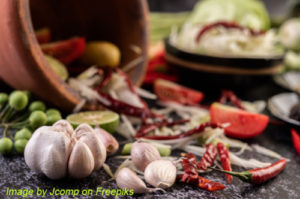Hototay is actually a Chinese egg drop soup that consists of meat and vegetables. It is a rich soup that is composed of pork, chicken and liver. It is an all-in-one meal that is perfect for rainy days or you can also eat it with rice as a viand. There are various ways to make chicken stock and I recommend boiling the chicken with black peppercorns, onions, carrots and a little salt.
You can use the boiled chicken on the hototay recipe below and also the chicken stock of course. Cooking this dish is very easy and ingredients are always available in wet markets or supermarkets. Just in case you can’t find fresh Shiitake mushrooms, you can use dried Chinese mushrooms (Shiitake or woodear fungus) by soaking it in hot water for a few minutes. Broccoli is an alternative in case you can’t really find mushrooms.
Hototay Soup: The Chinese-Filipino Comfort Classic
While it used to rain, this one surefire dish made our family gather around the dinner table. Raised in a small town, Pampanga, where everything spells comfort, this big bowl of soup would always warm me up as if a warm bowl was embracing me with what’s inside and snugly wrapped around the rainy atmosphere outside whenever my Tita Linda was at the stove ready for us. Though it originated from China, its recipe has been molded over time in many Filipino families into varied flavors and ingredients.
One of my cousins, Ate Josie, used to have a unique way of making the soup every time she came from Manila. It’s unbelievable how something so basic as soup can represent so much history, culture, or comfort.
What is Hototay?
Hototay is an egg drop soup with a Filipino twist of the Chinese type. The rich, savory broth forms from mixing chicken, pork and vegetables such as carrots, mushrooms, and pechay (Chinese cabbage) together. The outcome is quite filling that it can easily be a meal in itself. My lolo loved to dine with this with a side of rice as this completes his all-in-all order in one satisfying dish.
For me, it’s a fusion dish representing the best that Chinese and Filipino cooking have to offer. Wholesome, savory goodness has been synonymous with generations as comfort food, the perfect version always seeming to belong to the family.
The Secret to a Good Broth
Bottom line is the broth. Many of the Filipino soups rely on the broth as the base. My Tita made chicken stock the first time she made this for us. She swore by boiling the chicken with black peppercorns, onions, and carrots for that added depth of flavor to the soup. A pinch of salt was added at the start but not too much-seasoning could always be adjusted later.
She taught me never to rush through this process. Let the liquid slowly boil very softly, so all these flavors can blur together beautifully. I follow these words of wisdom every single time I make the soup. If you do have the time, you can certainly use store-bought chicken stock for it, but nothing can come close to the deep flavor one gets from homemade stock.
I always put the boiled chicken leftovers back into the pot, shredding it-it’s thrifty that way, and Lola Mila, my tough-skinned, tight-lipped matriarch, would love nothing better than to see none lost.
Substitutions and Adaptations
The beauty of making this soup lies in your ability to adapt to what you can avail from your kitchen or the local market. My brother Jun, who lives in a more remote part of Quezon, usually has a hard time finding fresh Shiitake mushrooms. In a pinch, dried Chinese mushrooms-whether Shiitake or woodear fungus-do the trick. Simply steep them in hot water for a few minutes until they are rehydrated and they’ll be ready to add to the soup. If mushrooms don’t float your boat or are hard to come by, you can substitute with broccoli. While it changes the texture of the soup just a bit, the flavor it imparts is its very own and mouthwatering enough.
To make it even more savory, you can also add the liver. Sometimes, people tend to be apprehensive about including this in the recipe; but don’t be afraid, try it out. My Tito Boy would always tell me that only one thing makes it richly flavored, and that is the liver. That is one step you may choose not to take but that indeed gives the dish a different twist to which you can easily play along with.
How to get the Egg Drop Technique Right
One of the defining ingredients of this dish is the egg drop that gives it that silky texture. So, if you’re thinking of adding one to your own egg drop soup, my cousin Ate Josie shares a secret that makes the difference: crack the eggs into a separate bowl first before you get your pot over the stove. This way, you can be sure that they’re not stale eggs since you could check them if they are still fresh, and you avoid any potential mishaps, as well.
Now, when you’re ready, gently pour your eggs into the soup while stirring. That way, you’ll get these lovely ribbons of cooked egg distributed throughout the broth. It is such a small thing but makes all the difference at that first sip.
A History in Every Dish
While many associate hototay with Chinese cuisine, it has become a favorite in many Filipino houses over the years. Really, what was originally a simple egg drop soup served in Chinese restaurants is now with a twist as far as most dishes were concerned.
In fact, hototay came from Chinese immigrants who brought it to the Philippines as a part of their culinary tradition. Through time, it evolved as it made incorporation of local ingredients and flavors to suit Filipino palates. This is really an example of how food easily crosses borders and cultures while keeping its core.
Suggested Service
Traditionally, the hototay was served solo. It has to be savored when the rain pours outside. In our household, however, hototay served with a bowl of warm white rice on the side. This makes it even thicker and more robust when my lolo mixed the rice directly into his bowl.
This soup is best enjoyed fresh and hot, when steamy whisps rise from the bowl. A sprinkle of chopped spring onions adds a splash of color and some extra flavor, but don’t forget the taste and adjust the seasoning before serving. Sometimes, just the right amounts of salt or a dash of soy sauce can really make it pop.
A Comforting Dish for All Occasions
In the final analysis, this is more than a soup – it is part of family history, a warm reminder of shared meals and comforting flavors. No matter if it’s the first time you make it or revisit an old favorite, I hope to be able to bring the same comfort and joy to your family as it has brought to mine over the years. There’s nothing quite like a bowl of this soup to warm the soul, especially on one of these rainy days.
So get your ingredients, take the time with your broth, and enjoy the process. And that’s why the best recipes are done with a little love and lots of care.
How to Make Hototay Soup
Ingredients
- 1/4 kilo pork sliced thinly
- 1/4 kilo boiled chicken breast shredded
- 1/8 kilo pig liver sliced thinly
- 6 cups chicken stock or chicken broth
- 2 cups Chinese cabbage or pechay Baguio chopped
- 1 cup Shitake mushrooms or woodear fungus chopped
- 1 cup carrots sliced
- 1/4 cup green onion chopped finely
- 1 pc red onion chopped
- 2 tsp garlic minced
- 4 pieces raw eggs
- 2 tsp. salt
- 1 tsp. ground black pepper
- 2 Tbsp. cooking oil
Instructions
How to cook Hototay Soup:
- In a medium size pot or wok, heat oil and saute garlic until fragrant.
- Next, add the onions and saute until soft.
- Then add the pork and saute for about 6 to 7 minutes until slightly brown.
- Add the pork liver and mix for a few seconds then pour a cup of water.
- Cover and simmer for a few minutes until the water is reduced to half a cup.
- Then add the shredded chicken, carrots and mushrooms.
- Mix the ingredients then add salt and pepper to taste.
- Pour the chicken stock. Bring to a boil and simmer for about 3 minutes.
- Then add the pechay Baguio, stir and simmer for 1 to 2 minutes.
- When cooked, transfer to individual bowls depending on how many people you are going to serve.
- Get some eggs and crack each egg in a small bowl before pouring it on the hototay soup.
- Don't crack the egg directly on the soup to avoid wasting it in case the eggs are bad.
- Garnish with spring onions and serve hot.
Notes
Cooking Tips:
Master the Broth for Deeper Flavor
The broth is the heart of any good soup. Hototay makes no exception: Use homemade chicken stock boiled with onions, carrots, and peppercorns for a richer taste. Let it simmer slowly to allow all the flavors to blend perfectly in giving your soup a deeper, more savory flavor.Rehydrate Dried Mushrooms Correctly
However, dry Shiitake or woodear fungus will do just as well, and can be excellent substitutions. Reconstitute by soaking them in very hot water for about 10 minutes before adding them to your soup. That way, the mushrooms will be soft and its flavor more deeply imbued, more so in the broth.Be Tender with the Eggs
Beat those eggs in another bowl, and whisk them gently into the soup, stirring lightly over heat to cook the egg to silky strands. Do not do that with clumpy eggs or anything like that - just let the egg slime away beautifully into the broth.






The best website so far that I have found for Pinoy recipes! Keep us salivating, Manny!
Hi Tony, thanks for the kind words! I hope you will often visit this blog!
I would love to try your recipes. They sound very authentic.